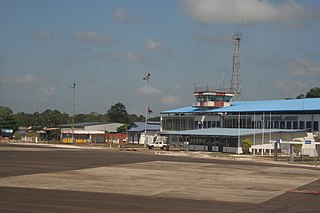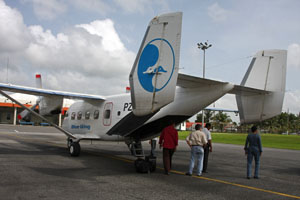
Sipaliwini is the largest district of Suriname, located in the south. Sipaliwini does not have a regional capital as it is directly administered by the national government in Paramaribo.

Johan Adolf Pengel International Airport, also known as Paramaribo-Zanderij International Airport, and locally referred to simply as JAP, is an airport located in the town of Zanderij and hub for airline carrier Surinam Airways, 45 kilometres (28 mi) south of Paramaribo. It is the larger of Suriname's two international airports, the other being Zorg en Hoop with scheduled flights to Guyana, and is operated by Airport Management, Ltd./ NV Luchthavenbeheer.

Kwamalasamutu, also Kwamalasamoetoe, is a Tiriyó Amerindian village in the Sipaliwini District of Suriname, and home to the granman of the northern Trios. Kwamalasamutu is the biggest village of the Tiriyó tribe.

Blue Wing Airlines n.v. is an airline with its head office on the grounds of Zorg en Hoop Airport in Paramaribo, Suriname. The airline started operations in January 2002 and operates charter and scheduled services from Paramaribo to destinations in the interior of Suriname, Guyana, Brazil, Venezuela and the Caribbean area. Its main base is Zorg en Hoop Airport. The airline is on the list of air carriers banned in the EU for safety violations. They were temporarily removed from the list on 28 November 2007 after implementing a corrective action plan ordered by the EU Transportation Commission. However, on 6 July 2010, the airline was banned again from European and French territory airspace as a result of three accidents involving Blue Wing Airlines: one on 3 April 2008 with 19 fatalities, another accident on 15 October 2009 that lead to four unspecified injuries, and a third incident on 15 May 2010 with 8 fatalities.

Zorg en Hoop Airport is an airport serving general aviation in the city of Paramaribo, Suriname. It is 3 kilometres (1.9 mi) west of the Suriname River, between the city quarters of Zorg en Hoop and Flora.

Tafelberg Airstrip is 9 kilometres (5.6 mi) south of the Tafelberg tepui in Suriname. It was constructed as part of Operation Grasshopper. It is also known as Rudi Kappel Airstrip, after the co-pilot of a flight that crashed near Vincent Fayks Airport.

Kabalebo Airstrip serves the village of Kabalebo, Suriname. It was constructed as part of Operation Grasshopper.

Kayser Airstrip is near the Kayser Mountains range in Sipaliwini District, Suriname. It was constructed as part of Operation Grasshopper and has one long grass runway. Fishing and wildlife tours are prime users of the airstrip.

Vincent Fayks Airstrip, in Paloemeu, Suriname. The airport was constructed as part of Operation Grasshopper. It was named after the Polish pilot Vincent Fajks who crashed with co-pilot Ronald Kappel with their Aero Commander AC 520 (PZ-TAG) airplane at the site in October 1959, while trying to deliver building materials for the airport. They both received a state funeral in Paramaribo on October 10, 1959. Paloemeu is a popular jungle resort on the Tapanahony River.

Kabalebo is a resort in Suriname, located in the Sipaliwini District. Its population at the 2012 census was 2,291.

Caricom Airways, which stands for Caribbean Commuter Airways, was a regional airline from the Caribbean, with the headquarters of the company at Paramaribo, Suriname. From the down-town Zorg en Hoop Airport in Suriname, Caricom Airways mainly flew charter flights to various destinations in the interior of Suriname, the Caribbean and Northern Brazil.
Gum Air is a Surinamese airline based at Zorg en Hoop Airport in Paramaribo, Suriname. Gum Air cooperates with Trans Guyana Airways to provide daily flights between Zorg en Hoop Airport (ORG) in Paramaribo, Suriname and Ogle Airport (OGL) in Georgetown, Guyana.

Oelemari Airstrip is an airstrip located near the Oelemari River in Suriname. This small grass airstrip was constructed as part of the Operation Grasshopper project in Suriname.

Avanavero Airstrip, near Avanavero, Suriname. It was one of the airstrips constructed in the aftermath of Operation Grasshopper.
The Luchtvaartdienst Suriname is the Civil Aviation Department of the Suriname Ministry of Transport, Communication and Tourism. It is responsible for the regulation of all aviation activities in the country, and ensures that all activities are carried out in compliance with international standards. It is a member of the International Civil Aviation Organization (ICAO).

Amatopo or Amotopo is a Tiriyó village on the Courentyne River in the Sipaliwini District of Suriname. The village lies next to the Amatopo Airstrip and about 7 kilometres (4.3 mi) upstream from the village of Lucie. The Frederik Willem IV Falls and Arapahu Island are located near the village.

Kuruni is a village in the Coeroeni resort in the Sipaliwini District of Suriname. The village is inhabited by indigenous people of the Tiriyó tribe. The inhabitants are of the subgroup Aramayana or the Bee people.

The Kayser Mountains is a mountain range in the Sipaliwini District of Suriname. It is named after Conrad Carel Käyser. The Kayser Airstrip was built in 1960 at the foot of the mountains as part of Operation Grasshopper to access the interior of Suriname.

Donderskamp is an indigenous village of Kalina Amerindians in the resort of Boven Coppename in the Sipaliwini District in Suriname. The village is located on the Wayambo River.










